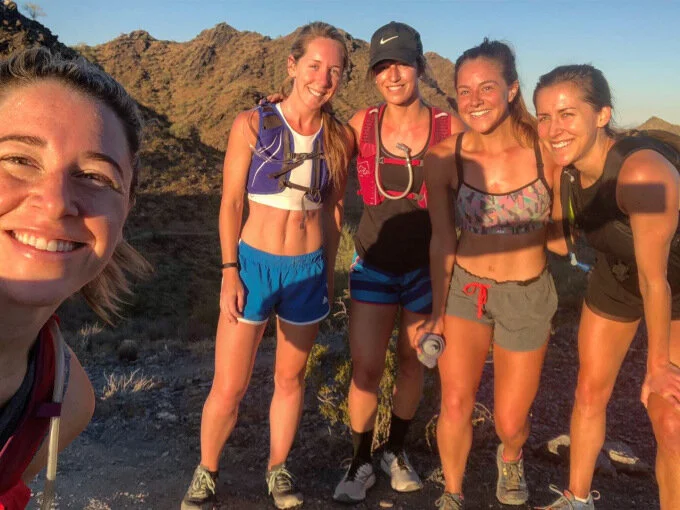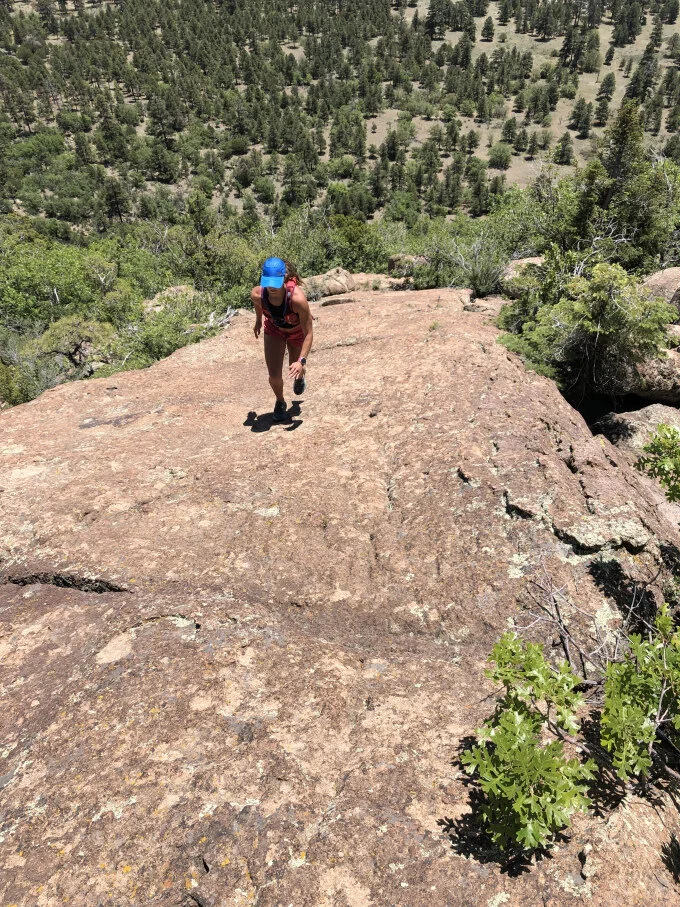Do Weight Lifting & Trail Running Go Together?
Before I really turned to the outdoors with hiking and trail running, I was invested in bodybuilding and Crossfit. While both of those seasons of my life were important for their own reasons, I see a vast difference in how I view and use my body now versus then.
When I was more focused on weight lifting, I was really focused on the aesthetics of my body, instead of what it can actually do. While Crossfit upped my endurance and I got in good shape, I still wasn't utilizing it to become a truly fit and apt person (some do, don't get me wrong, but I liked the results physically over the things it could allow me to do). Now, I see how weight lifting can compliment my goals as an athlete. It is a vehicle to help me balance out and strengthen muscle groups so that my body functions more efficiently, quickly and stronger over time. When I started taking running seriously I still wanted to balance working out, yoga, and doing other things that bring me joy. I didn't feel like I could get the hang of what would benefit me as a runner in the gym and what I could be doing to help me get stronger at my new passion. So I started researching.
Wild Women Running community members trail running in Phoenix, Arizona in the Phoenix Mountain Preserve.
If you're trying to figure out how to balance out lifting and running, I am still working on it. What I can say is: you should do both. Cross-training is really important for becoming a strong, well-rounded athlete and also helps you to stay injury-free. If you consider what you're doing on the trails, you'll realize just how many muscles you're actually working. The act of trail running demands different muscle usage along with uneven, varied terrain with a lot of ups and downs, which means you're using different sources of power all the time. Consider just the aspect of running downhill: “Effective downhill running requires superior strength of the posterior chain (muscles of the backside of the body) and proper femoral control (the alignment of the femur in the hip),” says Dr. A.J. Gregg, a Certified Strength and Conditioning Specialist at HYPO2 High Performance Sports Center in Flagstaff, Arizona. How do you get posterior chain strength? Lifting some weight.
Did you know there is never a time when both feet are on the ground at the same time when you're running? Runner's World states, "Each time you land, one leg absorbs multiple times your body weight at impact so focusing on single-leg strength and stability can add up to big performance gains and injury prevention." Their great guide for several exercises to incorporate here.
I do a lot of body weight workouts: pushups, pull ups, planks and sit ups, TRX rows and dips as well as weighted upright rows, cable pull downs and so. many. variations. of lunges. Squats, glute bridges and bands have become my best friend.
Girl trail running up the slabs of Elden Mountain in Flagstaff, Arizona
Some really useful exercises I focus on are:
1. Bulgarian Split Squats (from Runners World): "Start standing facing away from a bench or chair. Place the top of your right toes on the bench or chair with slight bend in right knee. Place hands on hips for balance. Bend left knee to lower right knee to floor. Press through left heel to return to starting position. Repeat for 10 reps then repeat on other leg. Complete 3 sets. Work toward 3 sets to fatigue (when you can’t do any more reps)."
Why: Split squats build the single-leg strength needed to propel you forward through the trails. They also challenge your balance and help build your smaller, stabilizing muscles that often get overlooked.
2. Overhead Squat (from Runners World): "Start holding the resistance band with both hands, feet shoulder-width apart, toes pointing slightly out, and raise arms up overhead, elbows locked. Hinge at the hips to send butt back to squat down as low as you can, encouraging gluteal contraction, and keeping your back as straight as possible. If you can't do a full squat at first, hold on to something stationary at shoulder height. Start by doing three sets of 10 with arms extended, then work up to doing three sets of 10 with your arms overhead."
Why: You need a lot of power—through a large range of motion—to run fast and efficient on the trail. This is especially true when the terrain heads uphill or is very technical, requiring maximum agility. The overhead squat is a time-tested exercise requiring full-body range of motion. It takes some practice to get it right, but there is no better exercise to encourage maximal gluteal and hamstring activation. You will gain strength and neuromuscular power you could never hope to achieve on a squat machine or with a typical half-depth standing squat.
3. Step-Ups (from MotivRunning): "Using a box or bench at a gym, or a picnic table or park bench, start with both feet on the ground. Step up with one foot, keeping the knee and ankle in alignment, and your hips square (picture keeping a level waistband). Step up onto the box and back down. Repeat with the opposite foot, and continue alternating feet. Build up to maintaining good form under fatigue. Do all reps on one leg before switching to the other."
Why: Step-ups teach you how to drive one leg at a time to improve running power. They also help build knee, ankle and hip stability, and help strengthen glutes and the whole posterior chain—which is important, Warner says, because runners are generally quad-dominant. These can be done on a box at a gym, on a park bench or even off the edge of a patio deck—with or without dumbbells or kettlebells in each hand.
4. Single-Leg Good Mornings (from MotivRunning): "Stand with knees slightly bent and arms at your sides. Lift one foot slightly off the ground. Keeping your knee aligned over your ankle and your hips square, reach forward as if picking up a tennis ball or barbell off the ground (it’s OK if you don’t reach down that far; hinge forward only as far as you can keep a flat back). Concentrate on stabilizing your spine and maintaining a flat back through the movement and not collapsing your chest as you bend at the waist. Return to standing. Repeat on that same leg."
Why: Like step-ups, Good Mornings work the postural chain to counter runners’ quad dominance. They work hamstrings and glutes like deadlifts, but don’t require weights. Single-Leg Good Mornings build ankle, knee and hip strength as well, which can help ward off ankle sprains. And maintaining postural integrity while doing this exercise helps reinforce good posture while running, which is critical to being able to breathe deeply.
5. Around The World Toe Taps (from MotivRunning): "Stand with feet hip-width apart, legs slightly bent. Lift one foot slightly off the ground, and reach it forward (picture the 12 o’clock position on a clock face), tapping your toe lightly to the ground. Move that same foot out to the side (3 o’clock), tapping your toe. Move the foot/leg to the back (6 o’clock), tap your toe to the ground. Move the foot/leg behind your standing leg and to the side (9 o’clock), tap your toe to the ground."
Why: Trail runners need strong—and mobile—hips. This exercise creates hip stability through a variety of positions and also works ankle stability. Plus, it challenges balance and forces strength and awareness through different planes (forward, back, side and side). Since running is moving in one direction, this can help diversify your awareness in different planes.
6. Alternating Side Planks (and any other plank variation!)
Why: Protecting against adductor injury, maintaining posture under fatigue, and improving upper body strength. This exercise also helps knee stability, which is essential for running effortlessly down technical descents. (Running Magazine Canada)
7. Glute Bridges: "Lie on your back with your knees bent and firmly on the ground. Lift at the waist so your body forms a straight line from the knees to the shoulders, and place the weight on your feet and shoulders. Straighten one leg for 10 seconds before switching to the other. Make sure there is no weight on your neck."
8. Clam Shells (from Healthline): "Lie on your side, with legs stacked and knees bent at a 45-degree angle. Rest your head on your lower arm, and use your top arm to steady your frame. Be sure that your hipbones are stacked on top of one another, as there is a tendency for the top hip to rock backward. Engage your abdominals by pulling your belly button in, as this will help to stabilize your spine and pelvis. Keeping your feet touching, raise your upper knee as high as you can without shifting your hips or pelvis. Don’t move your lower leg off the floor. Pause, and then return your upper leg to the starting position on the ground. Do 20 reps on each side."
Why: Not only is it incredible for strengthening the hips, glutes, and pelvis, but the clamshell can also help to prevent injury and ease lower back tension.
Do you have a favorite exercise you incorporate into your routine for running? Share in the comments, I'd love to hear them!
Still don't believe me that trail running is the creme de la creme of fitness?! Read this awesome article by Core Running that focuses on just how good the trails are for us!



